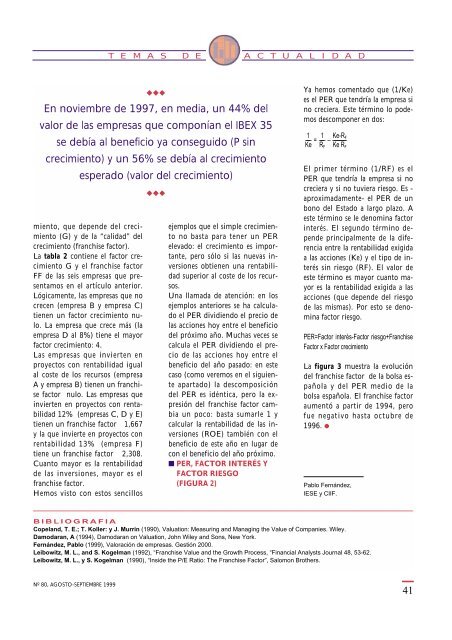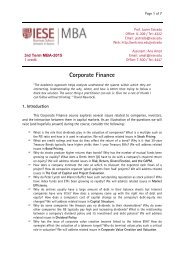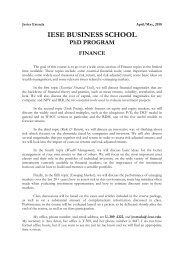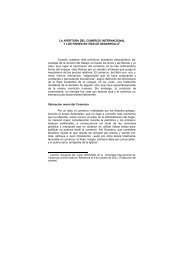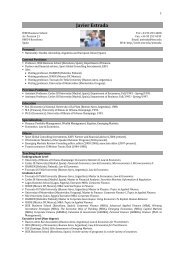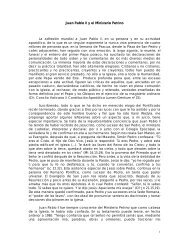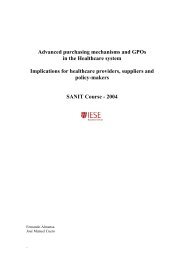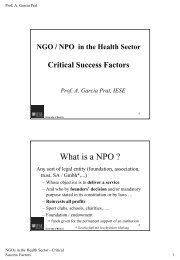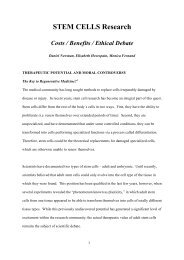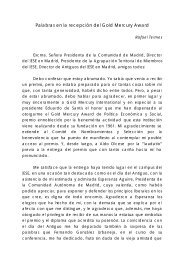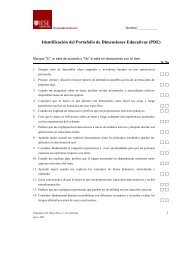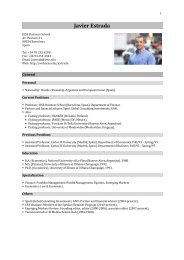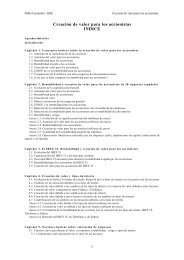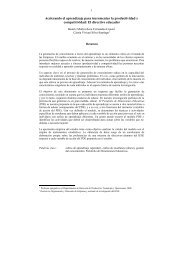PER, crecimiento y rentabilidad de una empresa
PER, crecimiento y rentabilidad de una empresa
PER, crecimiento y rentabilidad de una empresa
You also want an ePaper? Increase the reach of your titles
YUMPU automatically turns print PDFs into web optimized ePapers that Google loves.
miento, que <strong>de</strong>pen<strong>de</strong> <strong>de</strong>l <strong>crecimiento</strong><br />
(G) y <strong>de</strong> la “calidad” <strong>de</strong>l<br />
<strong>crecimiento</strong> (franchise factor).<br />
La tabla 2 contiene el factor <strong>crecimiento</strong><br />
G y el franchise factor<br />
FF <strong>de</strong> las seis <strong>empresa</strong>s que presentamos<br />
en el artículo anterior.<br />
Lógicamente, las <strong>empresa</strong>s que no<br />
crecen (<strong>empresa</strong> B y <strong>empresa</strong> C)<br />
tienen un factor <strong>crecimiento</strong> nulo.<br />
La <strong>empresa</strong> que crece más (la<br />
<strong>empresa</strong> D al 8%) tiene el mayor<br />
factor <strong>crecimiento</strong>: 4.<br />
Las <strong>empresa</strong>s que invierten en<br />
proyectos con <strong>rentabilidad</strong> igual<br />
al coste <strong>de</strong> los recursos (<strong>empresa</strong><br />
A y <strong>empresa</strong> B) tienen un franchise<br />
factor nulo. Las <strong>empresa</strong>s que<br />
invierten en proyectos con <strong>rentabilidad</strong><br />
12% (<strong>empresa</strong>s C, D y E)<br />
tienen un franchise factor 1,667<br />
y la que invierte en proyectos con<br />
<strong>rentabilidad</strong> 13% (<strong>empresa</strong> F)<br />
tiene un franchise factor 2,308.<br />
Cuanto mayor es la <strong>rentabilidad</strong><br />
<strong>de</strong> las inversiones, mayor es el<br />
franchise factor.<br />
Hemos visto con estos sencillos<br />
Nº 80, AGOSTO-SEPTIEMBRE 1999<br />
T E M A S D E A C T U A L I D A D<br />
◆◆◆<br />
En noviembre <strong>de</strong> 1997, en media, un 44% <strong>de</strong>l<br />
valor <strong>de</strong> las <strong>empresa</strong>s que componían el IBEX 35<br />
se <strong>de</strong>bía al beneficio ya conseguido (P sin<br />
<strong>crecimiento</strong>) y un 56% se <strong>de</strong>bía al <strong>crecimiento</strong><br />
esperado (valor <strong>de</strong>l <strong>crecimiento</strong>)<br />
◆◆◆<br />
ejemplos que el simple <strong>crecimiento</strong><br />
no basta para tener un <strong>PER</strong><br />
elevado: el <strong>crecimiento</strong> es importante,<br />
pero sólo si las nuevas inversiones<br />
obtienen <strong>una</strong> <strong>rentabilidad</strong><br />
superior al coste <strong>de</strong> los recursos.<br />
Una llamada <strong>de</strong> atención: en los<br />
ejemplos anteriores se ha calculado<br />
el <strong>PER</strong> dividiendo el precio <strong>de</strong><br />
las acciones hoy entre el beneficio<br />
<strong>de</strong>l próximo año. Muchas veces se<br />
calcula el <strong>PER</strong> dividiendo el precio<br />
<strong>de</strong> las acciones hoy entre el<br />
beneficio <strong>de</strong>l año pasado: en este<br />
caso (como veremos en el siguiente<br />
apartado) la <strong>de</strong>scomposición<br />
<strong>de</strong>l <strong>PER</strong> es idéntica, pero la expresión<br />
<strong>de</strong>l franchise factor cambia<br />
un poco: basta sumarle 1 y<br />
calcular la <strong>rentabilidad</strong> <strong>de</strong> las inversiones<br />
(ROE) también con el<br />
beneficio <strong>de</strong> este año en lugar <strong>de</strong><br />
con el beneficio <strong>de</strong>l año próximo.<br />
■ <strong>PER</strong>, FACTOR INTERÉS Y<br />
FACTOR RIESGO<br />
(FIGURA 2)<br />
Ya hemos comentado que (1/Ke)<br />
es el <strong>PER</strong> que tendría la <strong>empresa</strong> si<br />
no creciera. Este término lo po<strong>de</strong>mos<br />
<strong>de</strong>scomponer en dos:<br />
1 1 Ke-R F<br />
–= –– ––––––––––<br />
Ke R F Ke R F<br />
El primer término (1/RF) es el<br />
<strong>PER</strong> que tendría la <strong>empresa</strong> si no<br />
creciera y si no tuviera riesgo. Es -<br />
aproximadamente- el <strong>PER</strong> <strong>de</strong> un<br />
bono <strong>de</strong>l Estado a largo plazo. A<br />
este término se le <strong>de</strong>nomina factor<br />
interés. El segundo término <strong>de</strong>pen<strong>de</strong><br />
principalmente <strong>de</strong> la diferencia<br />
entre la <strong>rentabilidad</strong> exigida<br />
a las acciones (Ke) y el tipo <strong>de</strong> interés<br />
sin riesgo (RF). El valor <strong>de</strong><br />
este término es mayor cuanto mayor<br />
es la <strong>rentabilidad</strong> exigida a las<br />
acciones (que <strong>de</strong>pen<strong>de</strong> <strong>de</strong>l riesgo<br />
<strong>de</strong> las mismas). Por esto se <strong>de</strong>nomina<br />
factor riesgo.<br />
<strong>PER</strong>=Factor interés-Factor riesgo+Franchise<br />
Factor x Factor <strong>crecimiento</strong><br />
La figura 3 muestra la evolución<br />
<strong>de</strong>l franchise factor <strong>de</strong> la bolsa española<br />
y <strong>de</strong>l <strong>PER</strong> medio <strong>de</strong> la<br />
bolsa española. El franchise factor<br />
aumentó a partir <strong>de</strong> 1994, pero<br />
fue negativo hasta octubre <strong>de</strong><br />
1996. ●<br />
Pablo Fernán<strong>de</strong>z,<br />
IESE y CIIF.<br />
BIBLIOGRAFIA<br />
Copeland, T. E.; T. Koller: y J. Murrin (1990), Valuation: Measuring and Managing the Value of Companies. Wiley.<br />
Damodaran, A (1994), Damodaran on Valuation, John Wiley and Sons, New York.<br />
Fernán<strong>de</strong>z, Pablo (1999), Valoración <strong>de</strong> <strong>empresa</strong>s. Gestión 2000.<br />
Leibowitz, M. L., and S. Kogelman (1992), “Franchise Value and the Growth Process, “Financial Analysts Journal 48, 53-62.<br />
Leibowitz, M. L., y S. Kogelman (1990), “Insi<strong>de</strong> the P/E Ratio: The Franchise Factor”, Salomon Brothers.<br />
41


